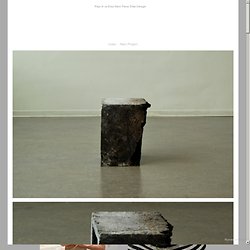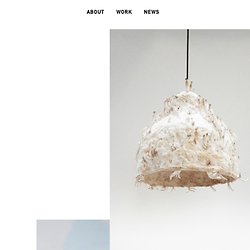

Mycelium Image Decay. A term being entered in the box below, images will be loaded from the Internet via Google, which then serve the mycelium for “food”.

In its growth the mycelium follows the structures of the images and makes them fleetingly visible before they are decomposed and composted. The mycelium generates a continuous process which leaves our perception to alternate between abstract patterns, familiar signs, and iconic forms. Exhibition / Video Serpula lacrymans in nutrient solution (top left) and in petri dish, 2002 Incubation of spruce wood with Serpula lacrymans, 2002 Thomas Feuerstein, One and No Chair (right) Thomas Feuerstein, Desk Philipp Mainländer (left) [Video] Hy-Fi: The Living's Local, Sustainable, 10,000 Brick Mushroom Tower At MoMA PS1.
Photos by Andrew Nunes Since 2000, the Museum of Modern Art and MoMA PS1's Young Architects Program (YAP) has sowed the grounds for the best and brightest emerging minds in architecture and design to create new and innovative projects that stretch the limits of sustainability and environmentally-minded urban construction.
![[Video] Hy-Fi: The Living's Local, Sustainable, 10,000 Brick Mushroom Tower At MoMA PS1](http://cdn.pearltrees.com/s/pic/th/sustainable-mushroom-creators-87786633)
This year's winner, The Living architects, under the auspices of principal, David Benjamin, dazzled the YAP's selection panel with Hy-Fi, a locally-sourced, virtually wasteless, and algorithmically-generated biostructure set to make its debut in the courtyard of MoMA PS1 in anticipation of their 2014 Warm Up summer music series. We went behind-the-scenes of Hy-Fi and spoke with creator David Benjamin about his unprecedented triumph in environmentally-minded, structurally-sound bio-design. To incite his desired paradigm-shift, Benjamin realized that existing construction materials and building processes just wouldn't cut it. Related: Possibly the Most Experimental Young Architects Program Building Material, Ever. A rendering of an aerial view of the The Living's Hy-Fi, the winning design of the 2014 Young Architects Program Credit: Courtesy The Living The architecture webosphere is abuzz about David Benjamin, co-founder of New York-based The Living, and his winning proposal for MoMA's 2014 PS1 Young Architects Program.

I have chronicled the provocative activities of The Living since my first Transmaterial book (Princeton Architectural Press, 2006), and the firm's experiments with gill-like breathing windows, micro-archipelagos of water-testing devices, and collective sensory networks for buildings have broadened our notions of what building products and architectural practice can be. As Joseph Giovannini reported last week in ARCHITECT, Benjamin's Hy-Fi installation at MoMA PS1 will be a brick tower that frames three circular oculi at the top, providing both shade and cooling breezes for summer visitors via stack-effect ventilation.
Mushrooms emerging in construction realm as insulation. To get off on the right foot, it’s not really mushrooms we are interested in.

More their maze-like roots, known as Mycelium. Mushrooms are merely the fruit of such roots, like the visible tip of a much larger, submerged iceberg. And no small iceberg, either. By some definitions Australia’s own Great Barrier Reef is considered the world’s largest living organism. If you’re measuring such things by area the top of your list might be the mycelium of the Armillaria solidipes or ‘honey mushroom’ of Oregon’s Blue Mountains. This vast unseen mycelium is where all the action is happening. Think about that for a moment. The beauty of Mycelium is that it can be harnessed. Multi-award winning Paul Stamets is an American mycologist (a fungi botanist), who could reasonably be considered the pioneer of modern uses for mushroom roots.
For example, using oyster myclelia his ‘myco-remediation’ was able to turn diesel fuel contaminated soil into nontoxic material suitable for landscaping. Acoustic tiles. Soilid - Papi X vs Erez Nevi Pana. Papi-X vs Erez Nevi Pana Total Design index Next project Soilid exhibits the combination of soil, fungi and other natural materials.

The recipe ingredients are measured by volume/weight and mixed together, then left to rise overnight at room temperature. The combination of the soil with fungi and sugars creates a chemical reaction that allows the "earth" to rise - the "dough" will double in size. 2013 Filed under Bio Design Soil Recrystallizing The Desert Soilid Neomadic Rosa Chair Humanature Aim Chair Delicate Skins New Born. JONAS EDVARD. Plant fibres and Mycelium The lamps consist of plant fibre and mushroom-mycelium.

The lamp is grown into shape during a period of 2-3 weeks, where the mushroom mycelium grows together the plant fibres into a flexible and soft living textile. After 2 weeks you can harvest the healthy Oyster mushrooms. The waste product ‘shaped as a lamp’ can then be dried and used as a lightweight material, that is both organic, compostable and sustainable.
Jonas Edvard’s Biodegradable Myx Lamp Grows Edible Oyster Mushrooms Jonas Edvard Myx Mushroom Lamp - Gallery Page 1. Eric Klarenbeek, mycelium chair. Patent US5074959 - Complex of fibers and fungi and a process for preparation thereof - Google Patents. 1.

Field of the Invention The present invention relates to a novel complex of fibrous materials and fungi obtained by allowing fungi to grow in a medium containing fibrous materials thereby bonding the fungi to the fibrous materials to the fungi. The complex of fibrous material with fungi is utilized as building materials such as fiberboards, heat insulating materials, and the like; sound materials such as acoustic diaphragms, speaker cones, and the like; base materials for fiber-reinforced plastics (FRP); packing materials such as packages for floppy diskets, envelopes and the like; paper; and the like.
As a result of employing the present process for preparing the complex, synthetic fibers containing the complex can be formed which exhibit a comfortable feeling. The present process is thus applicable to the fields of fibers and apparel. 2. In order to prepare paper from pulp manufactured from wood, a beating step is necessary during the manufacturing process.
MycoFARMX_Living Architecture by Walee Phiriyaphongsak. Terreform.